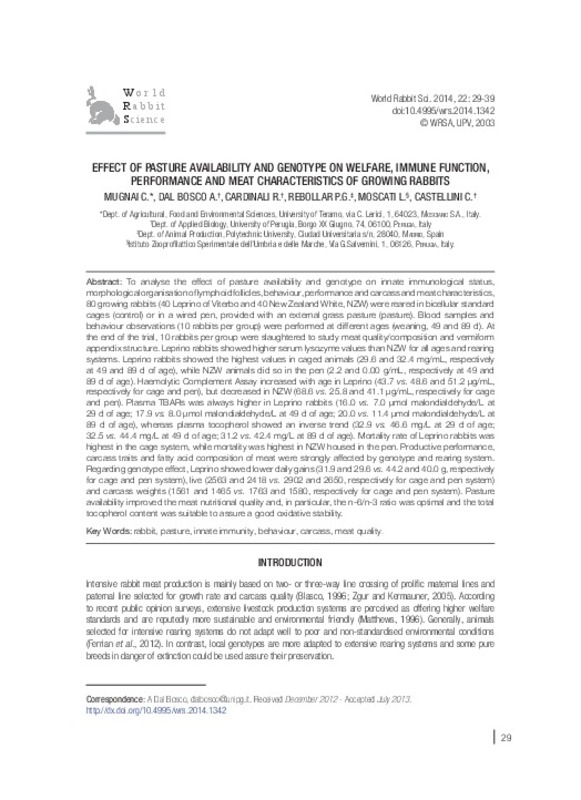JavaScript is disabled for your browser. Some features of this site may not work without it.
Buscar en RiuNet
Listar
Mi cuenta
Estadísticas
Ayuda RiuNet
Admin. UPV
Effect of pasture availability and genotype on welfare, immune function, performance and meat characteristics of growing rabbits
Mostrar el registro sencillo del ítem
Ficheros en el ítem
| dc.contributor.author | Mugnai, Cecilia
|
es_ES |
| dc.contributor.author | Dal Bosco, Alessandro
|
es_ES |
| dc.contributor.author | Cardinali, Raffaella
|
es_ES |
| dc.contributor.author | Rebollar, Pilar Garcia
|
es_ES |
| dc.contributor.author | Moscati, Livia
|
es_ES |
| dc.contributor.author | Castellini, Cesare
|
es_ES |
| dc.date.accessioned | 2014-07-29T07:00:23Z | |
| dc.date.available | 2014-07-29T07:00:23Z | |
| dc.date.issued | 2014-03-28 | |
| dc.identifier.issn | 1257-5011 | |
| dc.identifier.uri | http://hdl.handle.net/10251/39106 | |
| dc.description.abstract | [EN] To analyse the effect of pasture availability and genotype on innate immunological status,morphological organisation of lymphoid follicles, behaviour, performance and carcass and meat characteristics, 80 growing rabbits (40 Leprino of Viterbo and 40 New Zealand White, NZW) were reared in bicellular standard cages (control) or in a wired pen, provided with an external grass pasture (pasture). Blood samples and behaviour observations (10 rabbits per group) were performed at different ages (weaning, 49 and 89 d). At the end of the trial, 10 rabbits per group were slaughtered to study meat quality/composition and vermiform appendix structure. Leprino rabbits showed higher serum lysozyme values than NZW for all ages and rearing systems. Leprino rabbits showed the highest values in caged animals (29.6 and 32.4 mg/mL, respectively at 49 and 89 d of age), while NZW animals did so in the pen (2.2 and 0.00 g/mL, respectively at 49 and 89 d of age). Haemolytic Complement Assay increased with age in Leprino (43.7 vs. 48.6 and 51.2 μg/mL, respectively for cage and pen), but decreased in NZW (68.6 vs. 25.8 and 41.1 μg/mL, respectively for cage and pen). Plasma TBARs was always higher in Leprino rabbits (16.0 vs. 7.0 μmol malondialdehyde/L at 29 d of age; 17.9 vs. 8.0 μmol malondialdehyde/L at 49 d of age; 20.0 vs. 11.4 μmol malondialdehyde/L at 89 d of age), whereas plasma tocopherol showed an inverse trend (32.9 vs. 46.6 mg/L at 29 d of age; 32.5 vs. 44.4 mg/L at 49 d of age; 31.2 vs. 42.4 mg/L at 89 d of age). Mortality rate of Leprino rabbits was highest in the cage system, while mortality was highest in NZW housed in the pen. Productive performance, carcass traits and fatty acid composition of meat were strongly affected by genotype and rearing system. Regarding genotype effect, Leprino showed lower daily gains (31.9 and 29.6 vs. 44.2 and 40.0 g, respectively for cage and pen system), live (2563 and 2418 vs. 2902 and 2650, respectively for cage and pen system) and carcass weights (1561 and 1465 vs. 1763 and 1580, respectively for cage and pen system). Pasture availability improved the meat nutritional quality and, in particular, the n-6/n-3 ratio was optimal and the total tocopherol content was suitable to assure a good oxidative stability. | es_ES |
| dc.language | Inglés | es_ES |
| dc.publisher | Editorial Universitat Politècnica de València | |
| dc.relation.ispartof | World Rabbit Science | |
| dc.rights | Reserva de todos los derechos | es_ES |
| dc.subject | Rabbit | es_ES |
| dc.subject | Pasture | es_ES |
| dc.subject | Innate immunity | es_ES |
| dc.subject | behaviour | es_ES |
| dc.subject | Carcass | es_ES |
| dc.subject | Meat quality | es_ES |
| dc.title | Effect of pasture availability and genotype on welfare, immune function, performance and meat characteristics of growing rabbits | es_ES |
| dc.type | Artículo | es_ES |
| dc.date.updated | 2014-07-25T10:56:23Z | |
| dc.identifier.doi | 10.4995/wrs.2014.1342 | es_ES |
| dc.rights.accessRights | Abierto | es_ES |
| dc.description.bibliographicCitation | Mugnai, C.; Dal Bosco, A.; Cardinali, R.; Rebollar, PG.; Moscati, L.; Castellini, C. (2014). Effect of pasture availability and genotype on welfare, immune function, performance and meat characteristics of growing rabbits. World Rabbit Science. 22(1):29-39. https://doi.org/10.4995/wrs.2014.1342 | es_ES |
| dc.description.accrualMethod | SWORD | es_ES |
| dc.relation.publisherversion | https://doi.org/10.4995/wrs.2014.1342 | es_ES |
| dc.description.upvformatpinicio | 29 | es_ES |
| dc.description.upvformatpfin | 39 | es_ES |
| dc.type.version | info:eu-repo/semantics/publishedVersion | es_ES |
| dc.description.volume | 22 | |
| dc.description.issue | 1 | |
| dc.identifier.eissn | 1989-8886 |








